
Top Experiences for Tibet Photography Tour in Lhasa, EBC, Kailash, Nyingchi, Lhoka
Tibet is a perfect place for those that are interested in photography, whether on a professional level or just as an amateur photographer. The high mountains capped with snow and the stunning valleys make for some of the world’s best landscape shots, and the crisp clear air makes the pictures even sharper than at sea level.
There are also hundreds of monasteries to shoot and ancient towns and villages that have barely changed over the centuries, with the people living their lives in much the same way as their ancestors. A photography tour of Tibet with Tibet Vista can give you all of this and more and will leave you yearning to come back again with more memory cards for more photos. Why not follow our Tibet photography tips and check how to make the most of your Tibet Photography tour.
Before Your Departure for Tibet Photography Tour
Before heading off to the plateau to take millions of photos of the stunning scenery, landscapes, monasteries and temples, and Mount Everest, there are a few things to consider in booking your Tibet tour.
Travel Documents You Need to Visit Tibet
Independent travel is not permitted in Tibet Autonomous Region, so you will need to book your photography tour with a good and reliable tour operator like us, Tibet Vista. This is also needed to obtain the required permits that you will need to get to and travel around the Tibetan plateau region.
As well as your Chinese Entry Visa, which you need to get into China before heading for Tibet, you will need the Tibet Travel Permit (TTP), the Alien’s Travel Permit, and possibly the Military Permit and the Frontier Pass, depending on where you are heading for your tour. None of these permits and passes are available to individuals and must be applied for on behalf of the client by the tour operator.
The Tibet Travel Permit must be applied for well in advance of your trip, as they can take up to 20 days to process. The other permits are obtained by your tour guide once you are in Lhasa. The initial permit, the TTP, requires scanned copies of your passport and visa to apply for, and is used to make the applications for the other permits and passes as well. Our travel consultants will help your sort out the details via exchange of emails.
Best Time for Tibet Photography Tour
Traditionally, the best time for Tibet Photography tour varies. If you prefer to photograph Tibetan Festivals and unique Tibetan customs, best time would be June - September. You will be able to capture the grand celebration of Shoton Festival and Saga Dawa Festival, etc. If one intends to shoot Mt. Everest, mid-April to early June and Sept. to Oct. would be the perfect time; If one opts for shooting prairie and Tibetan nomads in Nagqu, May to Sept. would be the best time given the lush grassland. While Lhasa is suitable for photography all year round.
However, according to a professional photographer that has spent more than eight years in Tibet taking shots for media around the world, the best time for photography is in July and August.
July and August are well known in Tibet to be the rainy season months, when the monsoon affects the plateau and the heaviest rains are found. And it is this that attracts photographers in July and August the most. The general climate of Tibet is persistent throughout the year; strong sunshine, thin air, big differences in temperature between day and night, and a dry cool atmosphere (even in the rainy season). It is this mild climate that makes July and August the perfect time for photography.
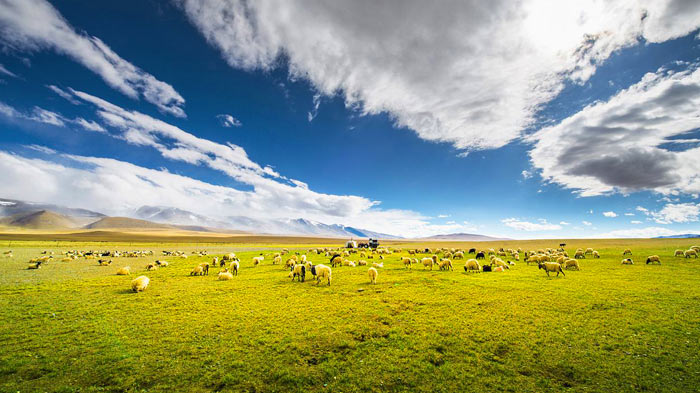 The best seasons in Tibet will offer you the stunning landscape
The best seasons in Tibet will offer you the stunning landscape
Clear blue skies are in no shortage of supply in Tibet, and at any time of the year, you can see this patter of the weather, as well as in the summer monsoon months when it is not raining. In Tibet, the monsoon does not have such a drastic effect as in lower monsoon counties, and what little rain there is normally falls in the afternoons or late evenings and overnight.
What is unique about July and August is the rain clouds and the unusual changes in the environment from before to after the rain has fallen. The unique changes in the cloud cover and the different ways that it affects the light and the scenery are some of the most spectacular aspects of the Tibetan monsoon season for photographers.
Prepare Your Camera Gears
Photography at high altitudes can put an undue strain on photographers, in terms of the high altitudes and the weight of their equipment. The best shots are normally reached on foot and carrying lots of heavy camera equipment around with you can be a huge burden. And with the Tibetan landscape being rough and rugged, it can make it even harder to carry lots of equipment.
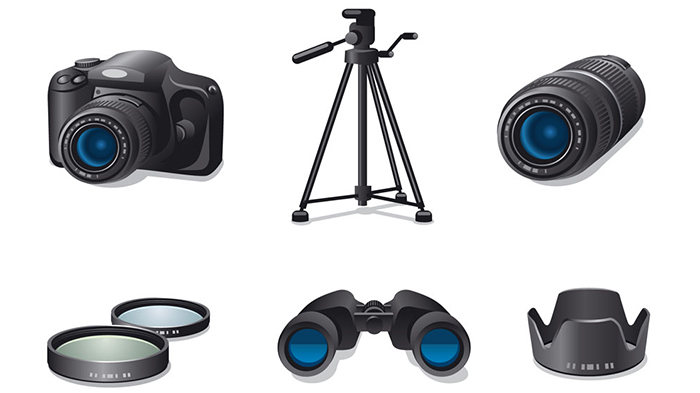 Prepare fewer camera bodies and more lenses to minimize the amount of equipment
Prepare fewer camera bodies and more lenses to minimize the amount of equipment
The best way around this is to minimize the amount of equipment you are taking with you. Fewer camera bodies and more lenses will give you the best options for almost all kinds of shots, and a smaller selection of filters is needed on the plateau due to the thinner atmosphere making the air crisper for better photography.
Stick to a folding tripod that weighs less, and can be extended to use when necessary, and ensure your cameras are digital rather than using 35mm film. Film does not work well at the high altitudes and lower temperatures of the plateau, whereas digital images can be sharper and clearer, and are less affected by the climate. And you should have somewhere to back up your photos once your shooting period is done each day, to preserve their integrity and safeguard them from damage.
Read more useful articles about photography in Tibet
>> Photographic Guide to Top Three Holy Lakes in Tibet
>> Advice for Shooting Temples and Palaces
>> Tips for Photography in Tibet
Must Dos for Tibet Photography Tour in and around Lhasa
With so many places to take your photos in Tibet, it is a good idea to know when and where to take the best shots of the places you will visit. Some monasteries have better lighting at certain times of the day or evening, while other opportunities only present themselves at certain times and can easily be missed.
Places such as Potala Palace and Jokhang Temple can be photographed at almost any time of day, and for Jokhang, it is a good idea to get there when the pilgrims are performing their prostrations and kora ritual, as these can make great shots. The Potala Palace can be photographed best from the nearby Chagpori Hill, or you can wait until the evening descends and get one of the most stunning shots of the palace lit up in the late evening.
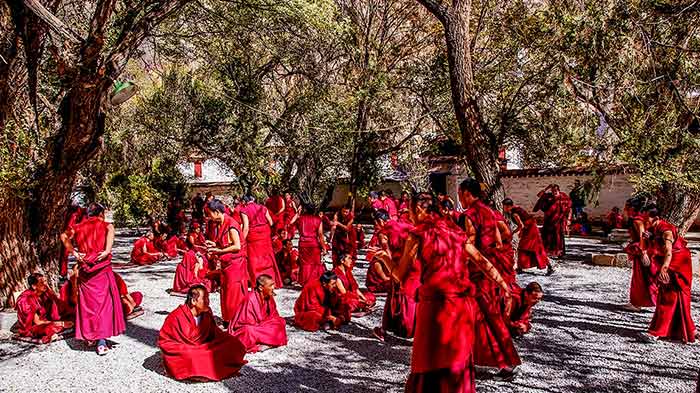 Amazing monastic debates in Sera Monastery
Amazing monastic debates in Sera Monastery
Of the major monasteries in Lhasa, Sera has the most spectacular opportunity fir photos, with the amazing monastic debates that are held there most afternoons. These debates are enthusiastic and vibrant and can be a great opportunity for an action shot of the monks in the middle of their heated debates on Tibetan Buddhist philosophy and semantics. Just make sure you have permission to take the photos first.
Around the Jokhang Temple lies Barkhor Street, the route of the kora for the devout Buddhists. It is also the main market and trading street in Lhasa for almost anything from quaint souvenirs to the finest examples of local Tibetan handicrafts. The atmosphere of Barkhor Street is one of religious and cultural exuberance and is a great place to get photos at any time of day.
For those with a penchant for lakes and landscapes, the nearby Lake Namtso to the north of Lhasa is a wondrous place to take photos. Popular with both Tibetan and Chinese couples for having their wedding photos taken, it is one of the most stunning locations in this spectacular landscape, and present endless opportunities for great photos. Sunrise and sunset at the lake show the light of the sun glinting off the rippling waters of this turquoise lake, known locally as the “Heavenly Lake”, which will soon become apparent. Near the Tashi Dor Monastery lies one of the many holy rocks of Tibetan Buddhism, and the lake has several hermitage caves that have been used for meditation for centuries.
Join-in Popular Lhasa Photography Tours
Must Dos for Tibet Photography Tour from Lhasa to EBC
One of the best trips to take for photography is the route that leads to Mount Everest, taking in many sights and towns along the way that offer opportunities for great shots. As you head out of Lhasa, the first place you come to of interest is the stunning Lake Yamdrok. One of the great Three Holy Lakes of Tibet, this vastly spread out lake has many arms and can be photographed from multiple angels and spots. For the best shot, it is recommended to take it from the pass just before you get to the lake, as it gives you a great view of the expansive lake spread out before you.
Further along, you will come to the Karola Glacier. One of Tibet’s astounding hanging glaciers, this massive icy glacier hangs off the mountainside like a giant frozen tongue, and its pristine whiteness makes for an awesome shot. In Gyantse, the most spectacular sight for shooting is the Gyantse Kumbum, a 32-meter-high stupa that is the largest of its kind in the world. It can be shot from all sides and from many angles, and you can even get as shot of the Kumbum from the upper levels, looking down at the town and the Pelkor Chode Monastery in which it lies.
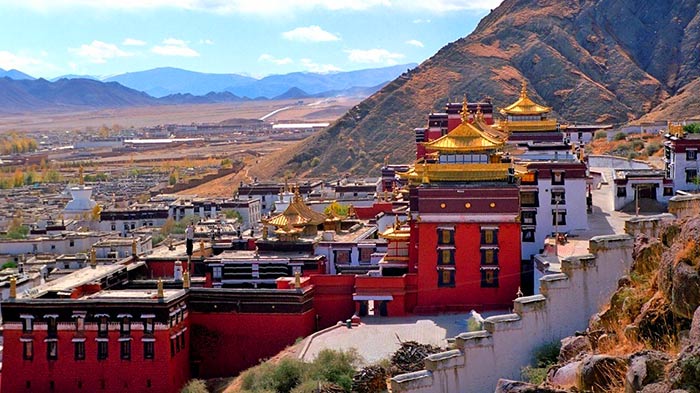 Taking the photo of Tashilhunpo Monastery in Shigatse
Taking the photo of Tashilhunpo Monastery in Shigatse
In Shigatse, Tibet’s second city, the Tashilhunpo Monastery is one of the most photographed monasteries in Tibet, and while not the oldest, it is definitely one of the most beautiful. The morning sunlight on the monastery is delightful, and shows the walls in a less glinting way, allowing for better shadows and details in the shots.
Gawu La Pass (5198m) is one of the most popular places to take photos of the Himalayan Mountains, as it is one of the few spots in Tibet where you can see many of the world’s highest mountains. From the crest of the pass, a wide vista of the Himalayas gives you a great view of Everest, Shishapangma, Cho Oyu, and Makalu in one panoramic shot.
Just before you get to Mount Everest’s base camp, you will want to stop at the Rongbuk Monastery, the highest monastery in the world. However, while the monastery does make for a great photo, it is even better known for the view of Mount Everest in the distance, which can be photographed in the morning or evening, as the rising and setting sun glints orange off the massive peak’s snow-clad slopes.
And the finale of any tour to Tibet is the unobstructed view of Mount Everest from the base camp itself. Towering high above the camp, the summit of the mountain is clearly visible almost all year round. Summer is also a great time to get a shot of the flag cloud that is attached to the peak of the mountain, blowing in the wind like some ethereal Buddhist hada, the traditional white Tibetan scarf.
Must Dos for Tibet Photography Tour from EBC to Mt. Kailash and Its Surroundings
Further north from Mount Everest, in Ngari Prefecture, lies one of the most amazing places for photography in Tibet. Mount Kailash, the sacred mountain, and the holy Lake Manasarovar are two of the most spectacular sights in Tibet, and are considered to be sacred in Buddhism, Hinduism, Jainism, and Bonism. A huge mass of black pyramidic rock, Mount Kailash stands tall above the surrounding mountains, and the site is one of the best places for learning about and photographing the pilgrims that often travel hundreds of miles to get there to perform the 52-kilometer kora trek around the mountain.
 The holy Mount Kailash
The holy Mount Kailash
Ngari Prefecture is also the site of the ancient Guge Kingdom of Western Tibet, which ruled majority of the area from the 10th to the 17th centuries. Once a great kingdom that spanned a vast area incorporating parts of what is now Jammu and Kashmir and Himachal Pradesh in India. Most of the kingdom now lies in ruins, and the ancient capital that lay at Tsaparang in the Sutlej Valley makes for one of the most spectacular locations for shooting ancient ruins.
Join-in Classic Mount Kailash Photography Tours
Must Dos for Tibet Photography Tour in Lhoka and Nyingchi
To the south of Lhasa lies another area ripe for photographers, in Shannan Prefecture, also known as Lhoka. Lhoka is the home of the ancient Samye Monastery, the oldest monastery in Tibet. Believed to be the first monastery built in the region by the former Tibetan king, Trisong Detsen, it is built on what the Indian monk, Samtaraksita, believed to be an auspicious place. The monastery stands out stark and white against the dull brown of the surrounding desolate countryside and is set against a backdrop of high Himalayan mountains.
To the east of Lhasa lies the Nyingchi Prefecture, the spring capital of all things Tibetan. Famed for its outstanding natural beauty, Nyingchi is one of the most stunning places in the region and is the lowest in altitude of all the prefectures of Tibet. In the spring, the peach blossom is out and is known worldwide for its beauty across the area. - Check the Best Time to Experience Nyingchi Peach Blossoms. However, there is more to Nyingchi than peach flowers.
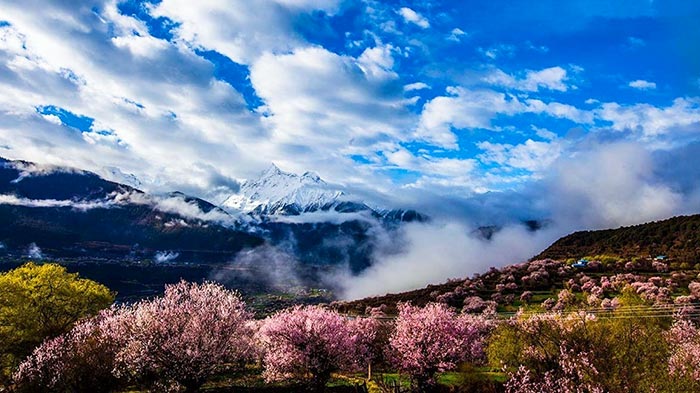 Peach flowers in Nyinchi
Peach flowers in Nyinchi
In the midst of the Niyang River, lies one of the most surprising shots for any photographer. The Niyang River is one of the main tributaries of the Yarlung Zangbo River, and in Tibetan the name means “sad tears of the fairy”. However, once you cross over the Mira Mountain from Lhasa, and drop down into this breathtakingly beautiful river valley, you will come across one of the most awesome sights in the area. Out in the middle of the river, standing all alone, is the Rock Pillar. This tall stone mesa lies in the middle of a river that has spent hundreds of thousands of years carving its path from the Tibetan plateau to the lowlands, yet this single pillar of rock remains after the millennia of water flow that has eroded everything else in the river.
Join-in Lhoka and Nyingchi Photography Tours

The Lhasa-born prodigy used to study business overseas, and got his Bachelor of Business in Nepal and India before moving back to his homeland. With pure passion for life and unlimited love for Tibet, Kunga started his guide career as early as 1997.
Responsible, considerate, and humorous, he devoted his entire life to guiding and serving international tourists traveling in Tibet. As a legendary Tibetan travel guru with 20-year pro guide experience. Currently, he is working in Tibet Vista as the Tour Operating Director. Whenever our clients run into trouble, he is your first call and will offer prompt support.


.jpg)



0 Comment ON "Top Experiences for Tibet Photography Tour in Lhasa, EBC, Kailash, Nyingchi, Lhoka"